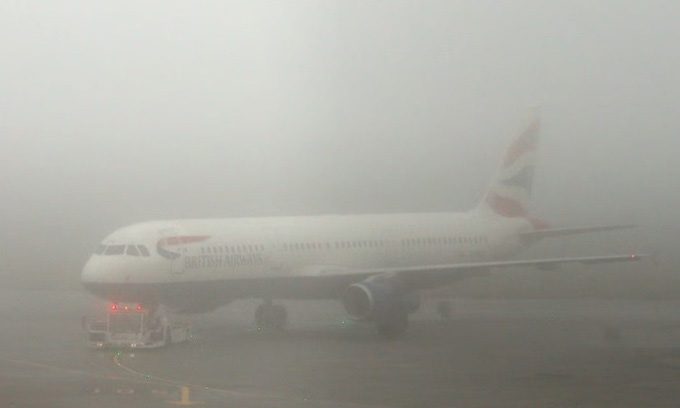Dense fog can reduce visibility, forcing pilots and air traffic controllers to use special procedures for takeoff and landing.
Fog at airports can disrupt airline operations. Depending on the season, fog leads to thousands of flight delays and cancellations worldwide each year. In winter, cold temperatures combined with high humidity increase the risk of more significant fog. Therefore, delays and cancellations tend to occur more often during winter.

Dense fog at Heathrow Airport. (Photo: PA).
Under normal conditions, air traffic controllers (ATC) and pilots can navigate aircraft using maps and visual data. However, when fog develops at an airport and visibility drops below 600 meters, the airport switches to Low Visibility Procedures (LVP). LVP significantly adjusts operations to ensure that there is more space and time on the airport to conduct safe maneuvers.
The most complex part of flying in fog is not taking off or landing but taxiing on the runway. Due to poor visibility at the airport, pilots and ATC must rely on maps and limited communication. When beginning to taxi, the aircraft must reach the designated point further away than usual by hundreds of meters to achieve the maximum distance during takeoff.
According to The Points Guy – a pilot, taxiing on the runway becomes even more complicated because entering the runway in low visibility conditions can result in disaster. This is why pilots sometimes choose to stop entirely and communicate with ATC, even when they have minimal knowledge of their exact position.
Takeoff
Once the aircraft successfully reaches the runway, the crew must reassess visibility conditions. Each type of aircraft and airport has a minimum visibility requirement for takeoff, which varies depending on the position on the runway. Only when the aircraft meets the minimum visibility criteria at all points on the runway will ATC allow the vehicle to begin takeoff.
Additionally, the runway needs to be clear until the aircraft is airborne, meaning that other aircraft cannot enter the designated point until the preceding vehicle is safely in the air. This is one of the reasons for flight delays. After the takeoff roll begins, the pilot must ensure the aircraft runs perfectly down the center of the runway and monitor for any unusual occurrences.
Landing
Landing in LVP is also a complex task. Since the minimum visibility for manual landing is 550 meters, pilots must rely on autopilot to land. To touch down in low visibility conditions, airports need to have landing support systems to connect with aircraft in thick fog.
After ATC approves landing, the pilot activates the autoland function to land on the runway and complete the touchdown while monitoring the system to ensure everything goes smoothly. They only regain control once the aircraft has landed and started taxiing to the terminal. Just like during takeoff, the runway needs to remain clear until the aircraft has completed its roll.
The foggiest airport in the world is located in California. Arcata-Eureka Airport experiences so many foggy days that the U.S. Navy uses this location to test fog reduction systems and train for all weather conditions.




















































